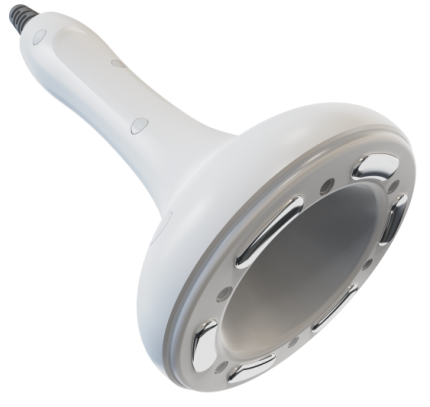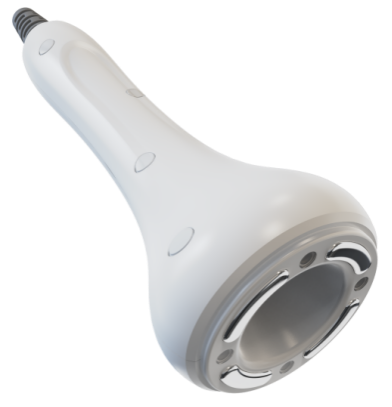In the field of non-invasive body carving, the vacuum system of cavitation machines can be called the “behind the scenes engineer”. This precision negative pressure device generates an adjustable pressure difference of -0.3 to-0.9 bar, just like a professional “fat architect”: it can gently lift skin tissue by 3-5mm to form a treatment window, and also increase the penetration efficiency of ultrasound energy by 40%. When 40kHz sound waves encounter the “low-pressure corridor” created by vacuum, they will stimulate more intense cavitation bubbles – these microscopic “blasting experts” accurately hit the fat cell membrane at a frequency of thousands of times per second, and the micro jet pressure generated is even comparable to the water pressure of 1000 meters in the deep sea.
During the operation, the vacuum intensity can be adjusted according to different parts and needs to ensure the safety and comfort of the treatment. For example, in areas with thick fat such as the abdomen or thighs, increasing negative pressure appropriately can more effectively destroy the structure of fat cells; In sensitive areas such as the arms or neck, it is necessary to reduce suction to avoid bruising or discomfort. Overall, vacuum not only optimizes the effect of cavitation in the cavity machine, but also enhances the overall comfort and shaping efficiency of the treatment, making it an important technical support for non-invasive fat reduction and skin tightening.


How Cavitation Machines Work: A Beginner’s Guide
Cavitation machine is a beauty instrument that achieves non-invasive fat reduction through ultrasonic technology. Its core principle is to use high-frequency sound waves to generate the “cavitation effect” in liquid media. When low-frequency ultrasound waves (usually 40-70kHz) emitted by machines penetrate the skin, millions of tiny vacuum bubbles are formed around fat cells. The mechanical pressure generated by the rapid expansion and rupture of these bubbles can effectively break the fat cell membrane, releasing triglycerides, which are then naturally excreted through the human metabolic system.
Modern cavitation machines are usually equipped with vacuum adsorption function, which improves the tightness of the skin contact surface through negative pressure, enhancing the efficiency of ultrasound transmission and synchronously stimulating lymphatic circulation. During operation, the treatment head moves in a circular motion on the surface of the skin, and the entire process is painless and non-invasive. Each treatment can reduce the thickness of the local fat layer by 1-3 centimeters, and sufficient drinking water is needed to accelerate the metabolism and breakdown of fat cells.
Understanding the Vacuum Mechanism in Cavitation Systems
The vacuum system of the cavitation machine extracts air from the treatment head through an electric pump to create a negative pressure environment (usually -0.3 to -0.6 bar). When the treatment head comes into contact with the skin, negative pressure will gently adsorb and lift the subcutaneous tissue by 2-4mm. At this time, the pressure sensor monitors in real time and automatically adjusts the suction strength. The specially designed silicone sealing ring ensures that the treatment head can maintain stable negative pressure when moving. This “dynamic adsorption” mechanism can enhance the penetration depth of ultrasound, promote local blood circulation, and avoid tissue damage. Throughout the process, the vacuum system and energy emission module work together to significantly improve the efficiency of fat decomposition.


Vacuum Handles
Optimizing Cavitation: The Vacuum Enhancement Effect
The cavitation device generates negative pressure of -0.3 to-0.6 bar through an intelligent vacuum system, which evenly stretches the skin tissue by 3-5mm. This reduces the acoustic impedance and increases the penetration depth of ultrasonic energy by 40%, reaching the fat layer directly; On the other hand, the mechanical stress generated increases the tension of the adipocyte membrane. When combined with 40kHz ultrasound, the micro jet generated by the rupture of cavitation bubbles can more efficiently destroy the cell membrane structure. The synchronized activation of lymphatic circulation accelerates the metabolism of free fatty acids, achieving a dual enhancement of “physical destruction+biological clearance”.
Optimizing Circulation: Vacuum Therapy’s Dual Benefits
The vacuum system of the cavitation instrument generates a “mechanical pump effect” through periodic negative pressure ranging from -0.2 to -0.5 bar: when the treatment head adsorbs, local capillary dilation increases blood flow by 60%, accelerating nutrient delivery. The pressure difference generated during release drives lymphatic reflux, which can promote the discharge of 2-3ml interstitial fluid per minute. This “suction discharge cycle” can effectively decompose the fibrous membrane, significantly improving the unique concave appearance of orange peel tissue. At the same time, negative pressure stimulation can enhance the sensitivity of adipocytes to catecholamines, further activating lipolytic enzyme activity.
Customized Vacuum Adjustment for Targeted Body Contouring
Modern cavitation instruments are equipped with a 7-speed adjustable negative pressure system (-0.1 to -0.9 bar), which achieves site adaptation through AI pressure sensing modules: in areas of fat accumulation such as the abdomen/thighs (subcutaneous fat>2cm), the high-intensity mode of -0.6 to -0.9 bar is automatically activated to ensure that ultrasound can penetrate the superficial fascia layer. For sensitive areas such as arms/neck (cortical thickness<1cm), switch to a mild range of -0.1 to -0.3bar, and use pulse adsorption technology (working for 2 seconds/intermittent for 1 second) to avoid capillary damage.
Clinical data shows that this dynamic regulation improves treatment safety by 40% while still maintaining a fat breakdown efficiency of over 85% in various parts. The 3D pressure sensing array built into the treatment head will monitor the tissue rebound force in real time. When muscle layers or bone processes are detected, the suction force will automatically decrease by 30%, achieving true “millimeter level precision negative pressure control”.
Optimizing Treatment Outcomes: Balancing Safety, Comfort and Efficacy
Modern cavitation equipment ensures therapeutic comfort through a triple safety mechanism: firstly, the dynamic pressure sensing system monitors changes in tissue impedance in real time, automatically reducing negative pressure by 0.2 bar when capillary pressure is detected; Secondly, the temperature control technology used in the treatment head can stabilize the epidermal temperature within the safe range of 38-42 ℃; Clinical data shows that this intelligent regulation reduces the incidence of bruising to below 3%.
Vacuum technology not only increases the fat breakdown rate by 30% through the “mechanical massage effect”, but its unique wave like adsorption rhythm (3-second adsorption/1-second release) can also simulate the tactile sensation of manual massage, reducing the patient’s pain score VAS from 5.2 points to 1.8 points. After treatment, infrared thermography showed that the vacuum assisted group had a 65% improvement in local microcirculation compared to the traditional ultrasound group, which explains why vacuum technology can increase skin tightness by an additional 40%.





